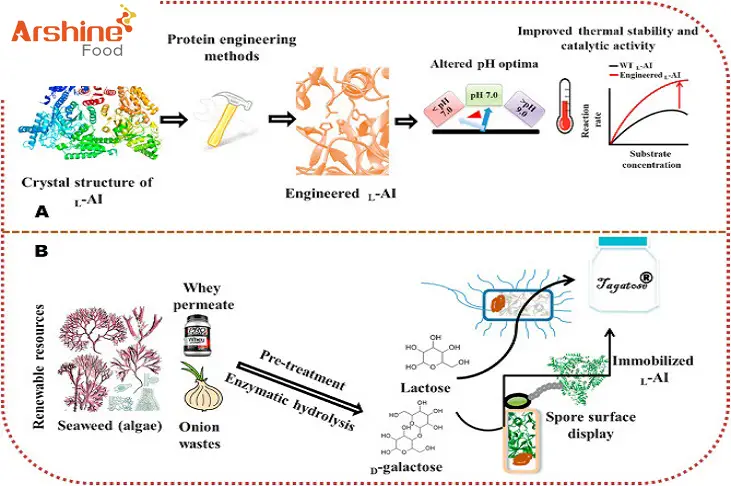In my country, L-arabinose has been approved as a “new resource food” and is widely used in various foods; the US FDA adds L-arabinose as a GRAS substance to food; Japan uses L-arabinose as a specific health food ingredient Added to foods with high glycemic and GI values.
L-arabinose is a naturally occurring functional five-carbon monosaccharide with a sweetness of 50% to 60% of that of sucrose. It provides a sweet taste similar to that of sucrose, and can also participate in Maillard reaction and pyrolysis in food production and processing. The saccharification reaction gives the product a good color and aroma; L-arabinose, as a functional sugar, can significantly reduce the blood sugar level and the GI value of sucrose, and reduce the digestion and absorption of sucrose by the human body; long-term consumption of L-arabinose, It can increase the body's glucose tolerance, reduce body fat, slow down weight gain, regulate intestinal flora, etc. Therefore, L-arabinose has broad application in compound sweeteners and compound functional raw materials.
Low GI, Low Energy Compound Sweeteners
Sweetness is one of the basic tastes of food. Humans have a long history of consuming sucrose, and have formed an inherent dependence on the sweetness of sucrose. Due to the extensive use of sucrose, a series of chronic diseases such as obesity and cardiovascular and cerebrovascular diseases have been caused due to long-term excessive intake. In recent years, both the country and the food industry have been actively advocating “sugar reduction” in the diet to create a healthy China.
The sweetness of L-arabinose is soft and not irritating, without any off-flavor, aftertaste, or chemical flavor. Its sweetness characteristics are similar to those of sucrose. L-arabinose is rarely absorbed by the human body while providing sweetness, and will not affect blood sugar and insulin levels; L-arabinose can significantly reduce blood sugar levels and GI values after eating sucrose. Studies have shown that adding 5% sucrose L-arabinose reduces the GI value of sucrose to 52.
Adding 5%~10% L-arabinose to sucrose is compounded into a sweetener, which can be widely used in high-sugar foods such as beverages, biscuits and cakes, candy chocolate, canned sugar, and other foods with added sucrose. The resulting increase in blood sugar and insulin will reduce the GI value of food, reduce the burden on the body, and achieve the purpose of “sugar reduction”.
Using L-arabinose as the main raw material, it is compounded with other sweeteners such as erythritol, xylitol, fructose, etc., and high-intensity sweeteners such as stevioside, mogroside, etc., due to sugar alcohols and sugar substitutes. The energy value is low or basically no energy value, which can reduce the high energy brought by high-sugar foods while ensuring the sweet taste.
Compound “prebiotics”
Studies have shown that L-arabinose can significantly proliferate beneficial flora such as Bifidobacterium longum and Bifidobacterium adolescentis, and has the effect of prebiotics. The combination of L-arabinose, xylo-oligosaccharide, fructooligosaccharide and other prebiotics can achieve the proliferation of various beneficial flora in the intestine, regulate the intestinal flora, and improve the intestinal microenvironment.
Compound lipid-lowering weight loss components
Long-term consumption of L-arabinose can significantly improve weight and body fat gain caused by a high-sugar, high-fat diet. The combination of L-arabinose and white kidney bean extract can achieve two-way blocking of carbohydrates in the diet; the combination of L-arabinose and konjac flour and other dietary fibers can increase satiety and basically not be absorbed by the body. These compound lipid-lowering and weight loss components are added to the meal replacement food, which can more effectively play the role of the meal replacement food in weight loss and shaping.
Compound laxative components
Studies have shown that L-arabinose has a better effect of smoothing bowel movements. Using L-arabinose as the main raw material, compound xylitol, xylo-oligosaccharide, isomaltose, etc. added to food can effectively relieve constipation and difficult defecation, and is now widely used in various solid beverages to promote defecation middle.
Compound coloring and flavoring
L-arabinose is a five-carbon monosaccharide. Compared with six-carbon sugars such as glucose, the Maillard reaction is more rapid and intense, and the resulting fragrance is softer and richer. The compound colorant of L-arabinose and D-xylose has been widely used in the coloring of meat products such as fish balls. The Maillard reaction of L-arabinose can also be used for browning lactic acid bacteria beverages, and it can be compounded with reducing sugars used in traditional Maillard reactions such as glucose, which can save energy and cost while giving products better color and aroma.
In addition, sweet and soft sugars such as L-arabinose and sucrose are added to white wine and fruit wine to make the wine softer and sweeter.
Application prospect of compound L-arabinose in food ingredients
As one of the few functional monosaccharides, L-arabinose exhibits good processing stability and various functional properties in food, whether used alone or in complex with sucrose, prebiotics, dietary fiber, etc. It has unique characteristics in improving product taste, color, texture, providing products with low GI, prebiotics and other functions, and has broad application prospects in the field of compound food ingredients.
https://www.arshinefood.com/detail/Industry-Information/L_arabinose_has_broad_application.html







